by Winding Pathways | Nov 18, 2014 | Nature, Preparedness
Few household items are as handy as a pair of binoculars. Sure, they are great for getting a close look at birds visiting the feeder, but they are also helpful to:
- inspect the roof from the ground for loose shingles. No climbing up a ladder.
- view from a distance butterflies, bees and other insects. No scaring them off.
- bring distant worlds into view from the backyard. In today’s overly lit cities and rural farmyards only a few stars are bright enough to see with the naked eyes. Binoculars bring many more into view along with planets, comets and even the International Space Station.
- make viewing ball games, concerts and large stage shows more interesting and intimate.
We don’t have just “a pair” of binoculars at Winding Pathways. We have several. Each of us keeps a pair in the car. One is near our dining room table, another in an upstairs bedroom and a final one in our offices. We also have a compact pair that gets tucked into the suitcase when we travel by plane.
Binoculars are an outstanding gift, but buying a quality pair without breaking the budget can get confusing. Dozens of brands and models flood the market and range in price from under $20 to several months mortgage payments. How do you choose?
Most people are best served by versatile general purpose binoculars. A few numbers are helpful to know. For example many binoculars are 8X40 or 8X42. The first number means how much magnification the binocs provide. In this case it’s eight power. The second number tells how large the lens is at the end of the binocular and indicates how much light it lets in. The bigger the number, the more light the binoculars let in and the wider the outer lenses are. In this case, if you divide the first number into the second, the result is around five. They will be a great general purpose pair of binoculars. Mini compact binocs commonly have a division factor of three. They will be easy to carry but less useful when the light is poor or for astronomy. On the other end of the spectrum are binoculars designed for low light. They will have large second numbers and are usually too big and bulky for general use but ideal for astronomy and spotting wildlife at dusk.
At Winding Pathways Rich prefers eight power binoculars and Marion uses 10 power models. As the power increases they become harder to hold steady without vibration and the field of view gets smaller. In other words you see less of the landscape with 10 power than with eight, so it may be harder to find that distant deer or bird. Ten power is great for people with steady hands.
Price gives some indication of quality. Avoid very inexpensive binoculars like the plague. If all you can afford is a $25 gift buy something other than optics. On the other hand there’s no point in buying expensive binoculars for general around the home use or for casual use. Fortunately optics on mid-priced binoculars has gotten much better in recent years, and outstanding models are available at modest cost.
We’ve used dozens of pairs of binoculars of many configurations and brands and believe those in the $125 to $250 price range are generally just fine for around the house use. Double the price and you’ll get better optics but you won’t get double the value because it takes companies more expense to get small improvements in quality.
Be sure the binoculars are comfortable in the hands, provide clear viewing, and are fun to use. We like to view butterflies and bees that are often only six to ten feet from our eyes, so close focusing is important to us.
So, what brand do we use? In recent years we’ve mostly purchased Alpen binoculars. They feature excellent optics at reasonable cost. But, many other brands are also outstanding. Binoculars can be purchased in stores, through catalogs or over the Internet. Buying in stores gives an opportunity to hold them and examine the optics before the purchase is made. Buying over the Internet makes returning, if necessary, easy and gives a chance to read reviews. Internet purchasing is becoming more common.
##
From time to time Winding Pathways will profile companies that provides equipment or services helpful in managing and enjoying wondrous yards. We have used their products and found them well made. However, we recognize that competing companies sell excellent products and services, so we encourage people to shop the market and find goods and services they like at a price they can afford.
In coming months Winding Pathways will feature profiles of Murray McMurray Hatchery, The Seed Savers Exchange, Milwaukee Tools and manufacturers of bird feeders.
Our inaugural profile is of the Alpen Outdoor Corporation.
Tim and Vickie Gardner established Alpen in 1996. He had been VP of Bausch and Lomb’s Bushnell division and wanted to provide a line of sports optics that delivers high quality and value. Alpen sells a wide array of binoculars and spotting and rifle scopes.
Although a relatively new company, Alpen has won several prestigious optics awards including Outdoor Life Magazine’s GREAT BUY award seven times and its EDITOR’S CHOICE award once.
Alpen is a family owned business and, although smaller than big brands, it is proud of its superb customer service and its” no fault” lifetime product guarantee.
When asked what distinguishes Alpen binoculars from other brands, Tim Gardner replied, “We work to provide more value and better quality compared to other manufacturers. We keep overhead low and concentrate more on customer service than fancy advertising.”
Here are his suggestions for general purpose around the home binoculars: “I recommend eight power as it gives the best brightness, field of view and ease of use. A full size 8X52 or 8X25 is outstanding for general use.”
When asked what binoculars were best for children he replied, “The most important thing is for the binocular to be able to adjust to fit the smaller face and closer set eyes of children. Alpen has an 8X30 model designed for kids. It has barrels that are close together to fit a child’s face. Some double hinge compact roof prism binoculars can also be adjusted to fit small faces”.
Contact Vicki or Tim at Alpen Outdoor Corporation, 10329 Dorset Street, Rancho Cucamonga,
CA 91730. (877)987-8370. www.alpenoptics.com.
by Winding Pathways | Nov 17, 2014 | Chickens, Children/Play, Nature, Reflections/Profiles, Wonderment
First Snow has a magic that draws children to it. Even some adults “get into” a first snow. Share your adventures and memories – current or past – of a First Snow. (Or any winter adventure you cherish.) Let us sparkle with life. For those who prefer to enjoy winter inside curled up with a good story, Robert Frost’s “Stopping By Woods On Snowy Evening” or John Greenleaf Whittier’s “Snowbound” both at Poetry Foundation are terrific reads.
*The idea of posting about the magic of first snow was inspired by Wahneta Tonn Dimmer’s FB post and hearing our neighbors’ children laugh as they belly slid down a slope by their home. Yes snow has its hazards and needs to be shoveled. But we can whistle while we work and appreciate the beauty of an Iowa winter in November.
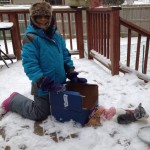
First Snow is magical.
Devany Souza – musher extraordinaire
“I was dog-sledding to Alaska. I had some medicine for the
children and all the grown ups who were sick. I put the medicine
in the box, with a blanket under it and on top of it, so it wouldn’t freeze. And the lead dog was my Husky named ‘Snowflake’.
The dogs’ paws froze and I had to put them in my sled and
push the sled until I got to Alaska. When I got to Alaska, everyone
got out of their cottages and cheered. I let my dogs off their harness and a lot of children came up and started petting them and they built
a statue of the three dogs and a statue of me. The End.”
Devany Souza as dictated to her mom, Kelly Carr Souza.
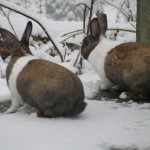
Considering their options.
Plotting a Winter Escapade
Summer Bunny and Jumping Bean were two intrepid Tortoise Shell Dutch Bunnies who loved to explore in summer and winter. They like the paths that we shoved for them best, but they were little deterred by snow. Hilarious to watch, they would seem to plot their adventures. Usually their paths took them under the gnarliest branches and into the thorniest thickets.
After a suitable romp they usually were ready to come back to the hutch for a snack and warming up in their bunny box. They always made winter fun.
“Hygge”

The infant snuggled close to her mama as snow drifted down outside.
“I made a conscious decision to stay home today. I did not touch my car, or anyone else’s car. We had a warm breakfast. We wore comfortable clothes. Around 11:00 a.m. the neighbor girl came over and drew my older daughter outdoors, where they mostly stayed until about 4:30 p.m., reveling in the newly fallen snow. Too powdery for snowmen or snowballs, but good for pulling a sled! My little one, of course, was intrigued by her older sister’s adventures. I found too-big snow pants for her and rolled up the legs; put on her coat and hat, and held her little hand as she shuffled down the sidewalk. In the afternoon, we had chicken noodle soup and a nap. I read my book. To the little one’s delight, we were not separated by more than an inch for most of the day. My sister came to visit and we toasted with a couple of glasses of wine and ate some salmon. I recently read about Danish “hygge”; there’s no good translation to English but it could be thought of as coziness, togetherness, and well-being that gets us through winter. We may have discovered it in Iowa already this winter! I hope it carries us through.” Sophie Nicholson
The Magic of Winter
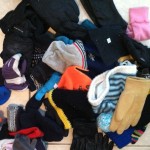
A typical winter scene – an assortment of gloves, mittens, hats, scarves all returned from a day on the snowy slopes.
“Children know how to do it right, celebrate winter that is! Watch the excitement in their eyes as the first snow flakes fall, then as the snow begins to accumulate on the grass, trees, patio swing and sidewalk. “Do you think it will be enough to go sledding, Mom?” my son asked.
“As a child I was fortunate enough to grow up in a five acre wood that was once home to a ski jump in rural Wisconsin. My brother, two cousins and friends from the neighborhood would bundle up and brave the Wisconsin winter cold for the thrill of the descent. From our side of the hill, we would climb a narrow, well worn trail through the woods. As we approached the top the ski slope would open up to reveal the valley to the south. We were well protected from any wintery winds by the tall hardwoods that lined the ski slope.
“The ride down was well worth the long trek up through the woods. The hill always kept its promise of a fast and exciting ride down. We would often have races to see who could reach the bottom first! I can only imagine in the stillness of the snowy countryside, that our giggles and squeals could be heard far and wide. When we just couldn’t bear walking up the hill one more time, our sled seemed like 50 pounds instead of five, our mittens were just too wet and our toes too cold, we would trek back down the trail in the woods. Mom would surely have hot cocoa and warm wintery treats waiting upon our return. She would welcome us home, pink cheeks and all. She would want to hear every detail of our adventure.
“What strikes me most in hindsight is the realization that we never worried about the time. We were so engrossed in the wonderful experience, the joy of it, the thrill of it, that we had not a care in the world. We were truly present and enthralled by the experiences that winter had blessed us with.
“An old friend once said, “It is not really about bad weather. It is really about having the right gear.” Whether you choose to bundle up and dive into the snow and cold or have the opportunity to witness the magic through a child’s eyes, allow yourself to get caught up in it. Magic is all around us. Take time to see it and experience it!” Wahneta Tonn Dimmer
The Severins welcome winter’s first snow with
the magical spirit of children.
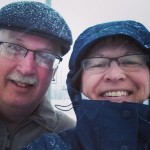
The Severins take on winter with a smile and dinner out!
“The first snowfall of the season descended in large fluffy clumps … the kind of snowflakes you want to try to catch on your tongue … the kind of snowflakes that sparkle and glisten in the light from the street lamps. We ventured out into the snowy night and shared in its magic.”
by Winding Pathways | Nov 16, 2014 | Nature, Wonderment
Bring nature inside this winter with a selection of books from two “nature friendly” stores. Winding Pathways encourages readers to shop locally to support small community businesses. Happy reading!

Step into the warmth of winter reading with a great selection at New Bo Books.
Books at New Bo Books
New Bo Books is a local bookstore affiliated with Prairie Lights Books in Iowa City. Check out their wide array of current adult topics and children’s classics for this Holiday Season.
For Children
A Leaf Can Be by Laura Purdie Salas. ISBN 9780761362036. A leaf is a leaf – or is it more? This poetic book helps little ones explore the role leaves play throughout the year.
If You Hold a Seed by Elly MacKay. ISBN 9789762447213. Inspire those you love; either a seed or a dream, planted and nurtured can grow. Beautiful illustrations!
Outside Your Window: A First Book of Nature by Nicola Davies. ISBN 9780763655495. An illustrated treasury of poems that reflect what children learn in their first encounters with nature.
Adult Nonfiction
Mountain Eyes by Scott Peters. Self-published. Wonderful photography and insightful reflections on man and nature from Scott Peters’ travels in Alaska, Patagonia and the Pacific Crest Trail. Number x120.
American Canopy by Eric Rutkow. ISBN 9781439193587. A broad historical study of the deep connection between America and its trees, from the colonial era to present day.
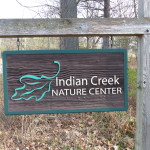
After a brisk walk on the trail stop in to pick up some great winter reading.
Books at Indian Creek Nature Center
Indian Creek Nature Center features a variety of books for children and adults. Certain general adult topic books are on sale for 20% off until gone. They also carry great nature/science kits for kids (Animal Tracks, Science on a Nature Walk, Going Green). New this year are all natural with bark still on building block sets and origami projects and books.
Just out: The Tallgrass Prairie Reader. Edited by John T. Price – University of Iowa Press ISBN-13 9781609382469. A wonderful collection of literature from and about the Tallgrass bioregion with voices and perspectives from the days of buffalo and immense prairies into the present. Individual writers honor the Tallgrass Prairie from their unique experiences and perspective.
Children’s Books
Hunting Red by Jean Snodgress Wiedenheft. ISBN 9780615907925. Inspired by the plants, animals and landforms of Indian Creek Nature Center, Hunting Red takes you on an adventure looking for the color red as it appears in nature.
The Prairie that Nature Built by Marybeth Lorbiecki. ISBN 9781584694922. Romp through the prairie above, below and all around while also discovering unique creatures and fragile places. This beautiful richly illustrated book also comes with a scan code to get the free pop-up app. Watch the animals pop up from each page!
Adult Nonfiction
The Locavore Way by Amy Colter. ISBN9781603424530. Discover and enjoy the pleasures of Locally Grown Food. Learn how to source, experience and savor the freshest foods from your area. Features sustainability, and organic and humanely raised food.
Home Herbal Remedies by Melanie Wenzel. ISBN9780778804895. Recipes, treatments, sources and identification guide with photos. Exceptionally complete guide written by a homeopath expert.
New Bo Books (Continued)
For Children
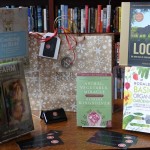
Great reading at New Bo Books!
On the Wing by Dave Elliott. ISBN 9780763653248. Take to the sky to explore all things avian – from the tiny, restless hummingbird to the Great Horned Owl. Verse and lovely illustrations.
The Great Kapok Tree: A Tale of the Amazon Rain Forest by Lynn Cherry. ISBN 9780152026141. A story to bring the larger story of endangered rain forests to life by taking the problem one creature at a time. Vibrantly colored watercolor drawings and a letter from the author to her readers to inspire care for the world.
These Bees Count by Alison Formento. ISBN 9780807578681. Can bees talk? Listen to their buzz as they count their way through fields and flowers.
This Tree Counts by Alison Formento. ISBN 9780807578902. Trees talk, if you listen very closely. Count your way through the worms, birds and others that need trees. In the end, trees most need friends like you!
Adult Nonfiction
Walden by Henry David Thoreau. ISBN 9781590306383. This lovely edition of the classic is complete with exquisite wood engravings that bring the text to life.
The Outermost House: A Year of Living on the Great Beach of Cape Cod by Henry Beston. ISBN 9780805073683. This modern twist on Thoreau’s Walden is a nature classic filled with the wonders of life itself. This book captures humanity’s relationship with nature.
A Sand County Almanac: And Sketches Here and There by Aldo Leopold. ISBN 9780195059281. Outdoor prose writing at its best by one of the foremost conservationists of our time. A book filled with beauty, vigor, and bite. Reveals Leopold’s deep love for a healthy land.
Adult Fiction
The River Why by David James Duncan. ISBN 9781578050840. Through the eyes of Gus, the young main character, we are led on a series of explorations into the wilds where the reader is treated to direct experience of the coastal rivers and forests. What begins as a physical journey becomes a spiritual one.
Poetry
Drift Ice by Jennifer Atkinson. ISBN 9780979745003. Atkinson evokes the natural world in loving detail. These poems move on inner currents and reveal astonishing worlds within our world.
Darkness Sticks to Everything: Collected and New Poems by Tom Hennen. ISBN 9781556594045. Hennen’s poetry is filled with attentive engagement with the natural world. He writes of seasonal weather, outdoor work, flora, fauna and a nuanced relationship to the upper Midwest.
Indian Creek Nature Center (Continued)
For Children
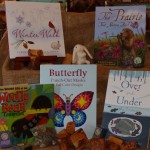
Nature comes alive in books
Winter Walk by Virginia Brimhall Snow. ISBN 9781423637479. All sorts of wonderful discoveries await while on a walk through the winter woods with Grammy. A warm, rhyming tale of animals, birds, trees and surroundings. Includes activities and winter trivia.
Wooly Bear Caterpillar by Laurence Pringle. ISBN 9781620910009. This bright, beautiful book reveals the secrets of the Wooly Bear Caterpillar. Why are they wooly? Find out! Excellent hardcover book for gift giving.
Adventure Board Book Series by Stan Tekiela. Preschool board books written by a naturalist and wildlife photographer. Charm is in the bright and clear pictures that bring the animals to life through fun facts.
Snouts & Sniffers ISBN 9781591934264.
Floppers & Loppers ISBN 9781591934240.
Peepers & Peekers ISBN 978159193423.
Paws & Claws ISBN 9781591934257.
Bird Color by Alison Hill Spencer. ISBN 9781591934288. Realistic and colorful this book introduces kids to birds they might see in their yard or the park as it teaches colors.
Smithsonian’s Nature Activities Bird Watcher by David Burnie. ISBN 075661029X. Hands on guide with easy activities, filled with facts and photos of birds. Also includes a fold out identification chart. Lots of fun!
Series by Claudia McGehee, University of Iowa Press. Each book presents learning opportunities illustrated by lovely scratchboard illustrations.
A Woodland Counting Book. ISBN 0877459894. Walk through the woods counting plants and animals from one to 50. Children will learn about the interactions of the woodland family and the seasons with notes for further discussion.
A Tallgrass Prairie Alphabet. ISBN 13 9780877458975. A prairie stroll follows the alphabet with flowers, animals and habitats. Beautifully and colorfully illustrated.
Where Do Birds Live? ISBN-13: 9781587299193. (not annotated)
Airplanes in the Garden – Monarch Butterflies Take Flight by Joan Z. Calder. ISBN 9780983296218. Monarchs are colorfully depicted throughout their life cycle as seen by a little girl who adopts two monarch caterpillars and shares their amazing transformation.
Animal ABC. Firefly books ISBN 13 9781770854567. (not annotated)
Series by Bobbie Kalman. Habitats, animals, weather, seasons, food sources and homes. Photos highlight each topic.
Backyard Habitats ISBN 10 0778729850.
A Grassland Habitat ISBN: 10: 0778729877.
Time for Kids – Butterflies! By the Editors of Time for Kids ISBN 13 9780060782139.
(not annotated)
Chickadee’s Message by Douglas Wood. ISBN 1591932289. Master storyteller shares an inspiring and timeless Native American folktale about goodness and beauty.
Who Was Here? Discovering Wild Animal Tracks by Mia Posada. ISBN 9781447718714.Wild animal tracks! First young readers find tracks and clues then turn the page to discover the animals they belong to!
Numbers in a Row. An Iowa Number Book by Patricia A. Pierce. ISBN 158536164X. All things Iowa counting from one to 100 reflects the wide variety of activities, history, locations, events and beauty all found in Iowa. Great way for kids to learn about the Hawkeye State!
Indian Creek Nature Center also carries great nature and science kits for kids (i.e. Animal Tracks, Science on a Nature Walk, Going Green) and new this year are all natural with bark on building block sets and origami projects and books.
Adult Nonfiction
Raw Energy by Stephanie Tourles. ISBN9781603424677. Nature’s Fast Food! Recipes to restore energy with simple, delicious, portable and raw snacks. Easy to make at home and take along such as bars, smoothies, juices and mixes. Pick it up to learn more!
by Winding Pathways | Nov 10, 2014 | Geology/Weather, Nature, Reflections/Profiles, Wonderment
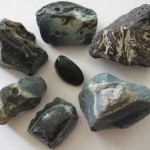
Obsidian has one characteristic that slag generally lacks – a hint of translucence.
On our recent Antiquities Tour, Rich and I came across interesting rocks on an abandoned railroad bed in Eastern Colorado. The chunks looked like obsidian. They fractured like obsidian and had the feel of obsidian. But, they didn’t quite look right. But blue and pretty! So, we put a bunch in the car. Rich was excited.
One of my geologists colleagues confirmed my observation on the fracturing and glassy feel of the rocks. But, they didn’t have the slightly translucent look of obsidian. Still I like them. So, I gave some to friends.
One scientist friend, Linda Mueller, appreciated the rock and investigated further. Here is our conversation on FB.
“I’ve been asking around about the rock you gave me. The consensus seems to be that the colors indicate that it’s slag glass and not obsidian. Certain areas in Colorado use it as railroad ballast. Obsidian and glass slag are so similar that it’s often difficult the tell the difference. Unscrupulous ebay sellers have taken advantage of this and have sold the artificial form as the real thing.
“Anyhow, whatever it is, I’m still fascinated by it. It’s beautiful and it will remain on my desk as a paperweight. Thank you again for it.”
I replied, “Thanks for checking this out!”
Linda added, “I was hoping for something interesting like turquoise. Still the stone is calming in a odd sort of way. It’s cool to the touch and smooth among the rough (parts).”
My thought: “Maybe good energy can come from slag. Say, that might be a good blog! Help me write it?”
So Linda did the work!
Linda: “I think so. The rock is truly entrancing. I can’t explain it. From the moment I saw it, I was fascinated by it. It was a special gift. I truly mean that.
“When you think about it, it does look a lot like obsidian, which is volcanic glass. I can’t remember what you said the spiritual properties of obsidian are but I wonder if they mirror the history of the stone? A huge amount of geothermal energy is needed to create obsidian. It flows from a volcano, then cools and solidifies. Tension moving toward calm? (Great analogy, I thought!)
“Glass slag is similar to obsidian; it, too, consists mainly of silica dioxide. It’s formed by heating ores (rock) to high temperatures. It’s a human-made rock, but it’s not a new technique. Humans have been creating it since the late bronze age (1500 – 1000 BCE). At least three thousand years! Wow! Ancient man found other uses for the leftover glass slag. They recycled it even then. Somehow we lost sight of that when technology gave us easier ways to make glass and pottery. Now we’ve come full circle and have found uses for it again.
“Might glass slag have properties similar to obsidian since the two are so similar? When I hold the rock, I feel calm. It takes away tension. The coolness and the weight of the stone is comfortable. Like obsidian, it was formed from heat/molten rock (tension) and it’s present state is cool/solid rock (calm).
“When you think about it, it fits. You and I have a strong interest in preservation, recycling, taking care of the earth. The rock cries out:
“‘Hey, look at the beauty and usefulness I have! Quit taking rocks from the earth to crush for railroad ballast when you already have me. I was needed for another purpose and now that it is complete, I’m moving on to my next one.’
“Everyone I’ve shown it to has had positive reactions to it. I wonder why that is?”
So, our on-line conversation ended here. But perhaps readers can weigh in and add to this. Obsidian or Slag – What Does it Matter?
The gift had the intention of love, perhaps that is a clue.










